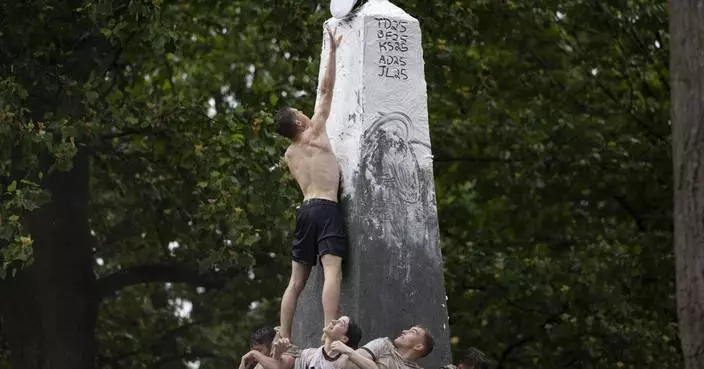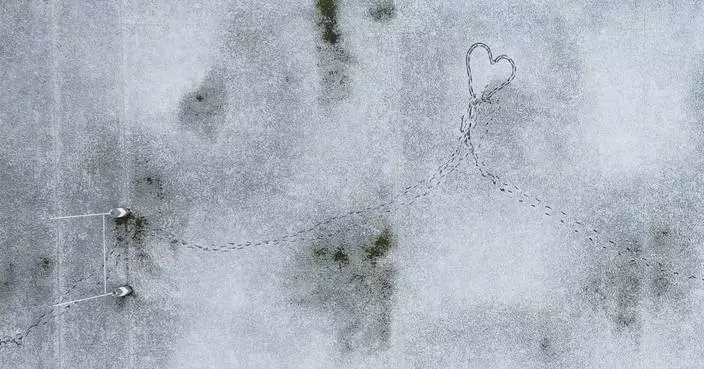Christie's auction house said Tuesday it has discovered a previously unknown copy of a 510-year-old map dubbed "America's birth certificate" because it gave the New World its name.

A world map in the form of a set of gores for a terrestrial globe, from 1507 by cartographer Martin Waldseemueller is displayed at Christie's auction rooms in London, Tuesday, Nov. 7, 2017.(AP Photo/Kirsty Wigglesworth)
Julian Wilson, a senior specialist in Christie's books department, said the two-dimensional globe created in 1507 by pioneering German cartographer Martin Waldseemueller is "the earliest piece of writing that uses the word America."
Click to Gallery
Christie's auction house said Tuesday it has discovered a previously unknown copy of a 510-year-old map dubbed "America's birth certificate" because it gave the New World its name.
Julian Wilson, a senior specialist in Christie's books department, said the two-dimensional globe created in 1507 by pioneering German cartographer Martin Waldseemueller is "the earliest piece of writing that uses the word America."
"This is the first time that America is on the map, in more ways than one," he said.
Wilson said the map is remarkably accurate. Waldseemueller was one of a group of cartographers based in Saint-Die, France that charted discoveries made by Spanish and Portuguese explorers and had access to the newest and most detailed information.
The map is being sold by the family of British paper restorer Arthur Drescher. He died in 1986, but relatives only recently found it among his papers and took it to the auction house to be appraised.
A world map in the form of a set of gores for a terrestrial globe, from 1507 by cartographer Martin Waldseemueller is displayed at Christie's auction rooms in London, Tuesday, Nov. 7, 2017. (AP Photo/Kirsty Wigglesworth)
Waldseemueller decided to name the landmass after Italian explorer Amerigo Vespucci, who helped show that lands being explored by Europeans in the 15th and 16th centuries were not — as Christopher Columbus initially surmised — part of Asia.
A wall-map version of the same chart by Waldseemueller, purchased by the Library of Congress for $10 million in 2003, has been called "America's birth certificate," and Wilson said the name equally applies to this version.

A world map in the form of a set of gores for a terrestrial globe, from 1507 by cartographer Martin Waldseemueller is displayed at Christie's auction rooms in London, Tuesday, Nov. 7, 2017. (AP Photo/Kirsty Wigglesworth)
"This is the first time that America is on the map, in more ways than one," he said.
Christie's plans to offer the map for sale in London Dec. 13, and set the price it is estimated to fetch at between 600,000 pounds ($788,000) and 900,000 pounds ($1.2 million). Four other copies of the map exist in museums and private collections, but this one was previously unknown.
The map is the oldest-known printed globe, designed to be cut out and pasted around a wooden ball. It is also the first map to show North and South America as separate continents and to depict a distinct Pacific Ocean, which no European had then seen.

A world map in the form of a set of gores for a terrestrial globe, from 1507 by cartographer Martin Waldseemueller is displayed at Christie's auction rooms in London, Tuesday, Nov. 7, 2017. (AP Photo/Kirsty Wigglesworth)
Wilson said the map is remarkably accurate. Waldseemueller was one of a group of cartographers based in Saint-Die, France that charted discoveries made by Spanish and Portuguese explorers and had access to the newest and most detailed information.
He said the map has "some quirks," including "a very large Sri Lanka and a very small India." Japan is placed in the mid-Pacific and Australia is missing.
"But the major geo-political features of the globe that we would recognize today are for the first time visible on this piece of paper," Wilson said.

A world map in the form of a set of gores for a terrestrial globe, from 1507 by cartographer Martin Waldseemueller is displayed at Christie's auction rooms in London, Tuesday, Nov. 7, 2017. (AP Photo/Kirsty Wigglesworth)
The map is being sold by the family of British paper restorer Arthur Drescher. He died in 1986, but relatives only recently found it among his papers and took it to the auction house to be appraised.
Wilson said "it completely freaked me out" when a man walked in off the street with the document.
"My legs almost gave way," he said. "It was a once-in-a-lifetime discovery moment. I thought, I'm probably looking at the find of my career."

A world map in the form of a set of gores for a terrestrial globe, from 1507 by cartographer Martin Waldseemueller is displayed by Julian Wilson, Specialist from the Books and Manuscripts Department, at Christie's auction rooms in London, Tuesday, Nov. 7, 2017. (AP Photo/Kirsty Wigglesworth)

A world map in the form of a set of gores for a terrestrial globe, from 1507 by cartographer Martin Waldseemueller is displayed at Christie's auction rooms in London, Tuesday, Nov. 7, 2017. (AP Photo/Kirsty Wigglesworth)
VATICAN CITY (AP) — The Vatican on Friday radically reformed its process for evaluating alleged visions of the Virgin Mary, weeping statues and other seemingly supernatural phenomena that have long punctuated church history, putting the brakes on making definitive declarations unless the event is obviously fabricated.
The Vatican’s doctrine office overhauled norms first issued in 1978, arguing that they were no longer useful or viable in the internet age. Nowadays, word about apparitions or weeping Madonnas travels quickly and can actually harm the faithful if hoaxers are trying to make money off people's beliefs or manipulate them, the Vatican said.
The new norms make clear that such an abuse of people's faith can be punishable canonically, saying, “The use of purported supernatural experiences or recognized mystical elements as a means of or a pretext for exerting control over people or carrying out abuses is to be considered of particular moral gravity.”
The Catholic Church has had a long and controversial history of the faithful claiming to have had visions of the Virgin Mary, of statues purportedly weeping tears of blood and stigmata erupting on hands and feet mimicking the wounds of Christ.
When confirmed as authentic by church authorities, these otherwise inexplicable signs have led to a flourishing of the faith, with new religious vocations and conversions. That has been the case for the purported apparitions of Mary that turned Fatima, Portugal, and Lourdes, France, into enormously popular pilgrimage destinations.
Church figures who claimed to have experienced the stigmata wounds, including Padre Pio and Pope Francis’ namesake, St. Francis of Assisi, have inspired millions of Catholics even if decisions about their authenticity have been elusive.
Francis himself has weighed in on the phenomenon, making clear that he is devoted to the main church-approved Marian apparitions, such as Our Lady of Guadalupe, who believers say appeared to an Indigenous man in Mexico in 1531.
But Francis has expressed skepticism about more recent events, including claims of repeated messages from Mary to “seers” at the shrine of Medjugorje in Bosnia-Herzegovina, even while allowing pilgrimages to take place there.
“I prefer the Madonna as mother, our mother, and not a woman who’s the head of a telegraphic office, who sends a message every day at a certain time,” Francis told reporters in 2017.
And the phenomena have also been a source of scandal. That was the case when the Vatican in 2007 excommunicated the members of a Quebec-based group, the Army of Mary, after its foundress claimed to have had Marian visions and declared herself the reincarnation of the mother of Christ.
The revised norms acknowledge the real potential for such abuses and warn that hoaxers will be held accountable, including with canonical penalties.
The new norms reframe the Catholic Church’s evaluation process by essentially taking off the table whether church authorities will declare a particular vision, stigmata or other seemingly divinely inspired event supernatural.
Instead, the new criteria envisages six main outcomes, with the most favorable being that the church issues a noncommittal doctrinal green light, a so-called “nihil obstat.” Such a declaration means there is nothing about the event that is contrary to the faith, and therefore Catholics can express devotion to it.
The bishop can take more cautious approaches if there are doctrinal red flags about the reported event. The most serious envisages a declaration that the event isn’t supernatural or that there are enough red flags to warrant a public statement “that adherence to this phenomenon is not allowed.”
The revised norms allow that an event might at some point be declared “supernatural,” and that the pope can intervene in the process. But “as a rule,” the church is no longer in the business of authenticating inexplicable events or making definitive decisions about their supernatural origin.
And at no point are the faithful obliged to believe in the particular events, said Argentine Cardinal Víctor Manuel Fernández, the head of the Vatican doctrine office.
“The church gives the faithful the freedom to pay attention” or not, he said at a news conference.
Despite the new criteria, he assured that the church's past decision-making on alleged supernatural events — such as at Fatima, Guadalupe or Lourdes — remains valid.
“What was decided in the past has its value,” he said. “What was done remains.”
Neomi De Anda, executive director of the International Marian Research Institute at the University of Dayton, said the new guidelines represent a significant but welcome change to the current practice, while restating important principles.
“The faithful are able to engage with these phenomena as members of the faithful in popular practices of religion, while not feeling the need to believe everything offered to them as supernatural as well as the caution against being deceived and beguiled,” she said in an email.
Whereas in the past the bishop often had the last word unless Vatican help was requested, now the Vatican must sign off on every recommendation proposed by a bishop.
Fernández acknowledged that the Vatican’s previous way of handling reported apparitions often led to “considerable confusion” among the faithful, as well as lengthy delays in reaching a definitive ruling. To date, fewer than 20 apparitions have been approved by the Vatican, according to Michael O’Neill, who runs the online apparition resource The Miracle Hunter.

Pope Francis in his popemobile leaves at the end of a Mass where he canonized shepherd children Jacinta and Francisco Marto at the Sanctuary of Our Lady of Fatima, Saturday, Friday, May 13, 2017, in Fatima, Portugal. On Friday, May 17, 2024, the Vatican will issue revised norms for discerning apparitions "and other supernatural phenomena," updating a set of guidelines first issued in 1978. (Paulo Novais/Pool Photo via AP, File)

Pilgrims pray at the Roman Catholic shrine in Lourdes, southwestern France, Friday, Feb.11, 2022. On Friday, May 17, 2024, the Vatican will issue revised norms for discerning apparitions "and other supernatural phenomena," updating a set of guidelines first issued in 1978. (AP Photo/Bob Edme, File)
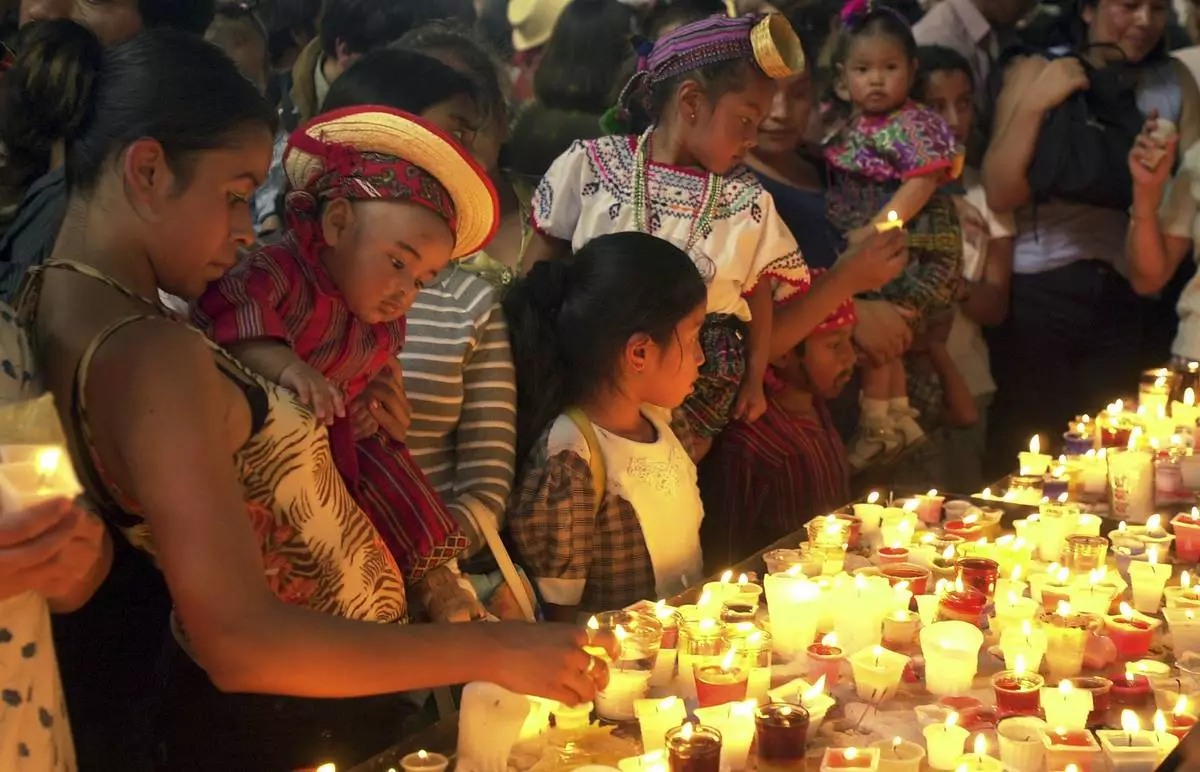
Faithful light candles while visiting the Virgin of Guadalupe's Sanctuary to celebrate her day in Guatemala City on Thursday, Dec. 12, 2002. On Friday, May 17, 2024, the Vatican will issue revised norms for discerning apparitions "and other supernatural phenomena," updating a set of guidelines first issued in 1978. (AP Photo/Jaime Puebla, File)
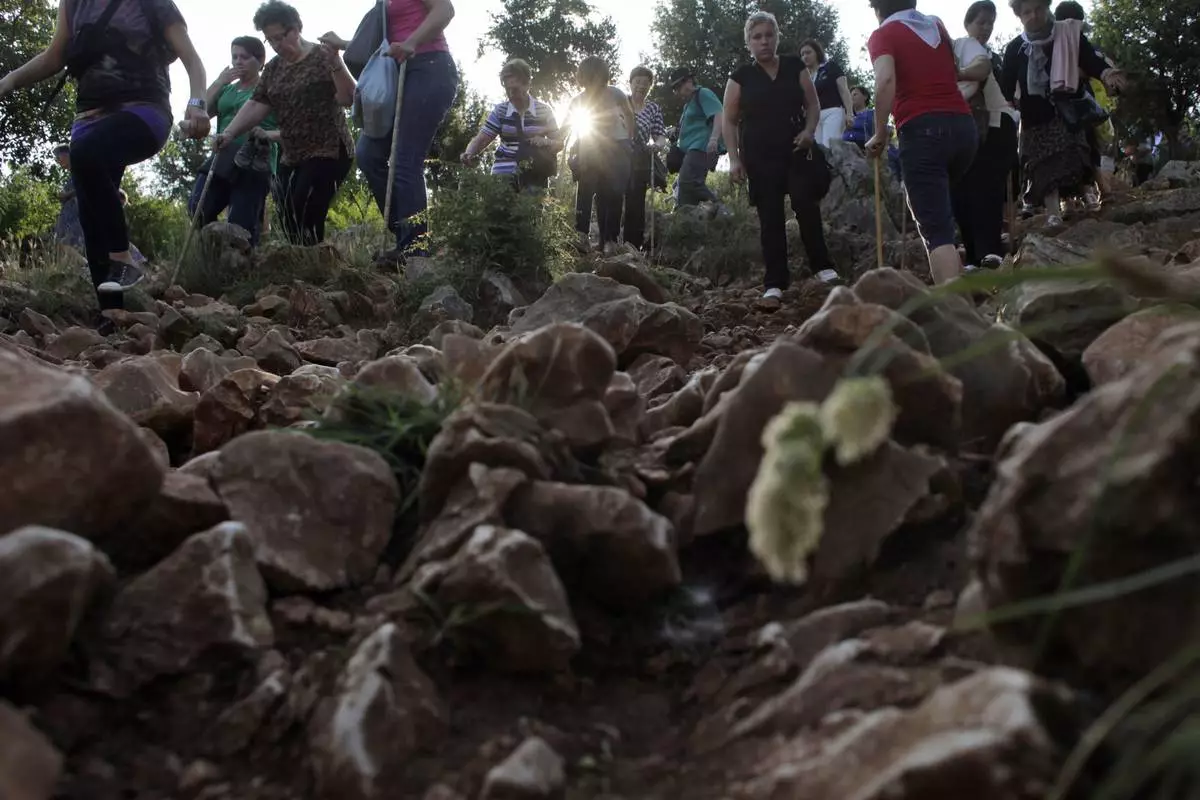
Pilgrims walk on a rocky terrain to say their prayers on the Hill Of Appearance in Medjugorje,100 km south of Sarajevo, Monday, June 25, 2012, where it is believed that the Virgin Mary showed herself and conveyed messages of peace to six children on June 25, 1981. On Friday, May 17, 2024, the Vatican will issue revised norms for discerning apparitions "and other supernatural phenomena," updating a set of guidelines first issued in 1978. (AP Photo/Amel Emric, File)

Pilgrims say prayers at the 'Hill of Appearance' in the southern-Bosnian town of Medjugorje, 100 kms south of Sarajevo, on Friday, June 25, 2010, where it is believed that the Virgin Mary showed herself and conveyed messages of peace to six children on June 25, 1981. On Friday, May 17, 2024, the Vatican will issue revised norms for discerning apparitions "and other supernatural phenomena," updating a set of guidelines first issued in 1978. (AP Photo/Amel Emric, File)
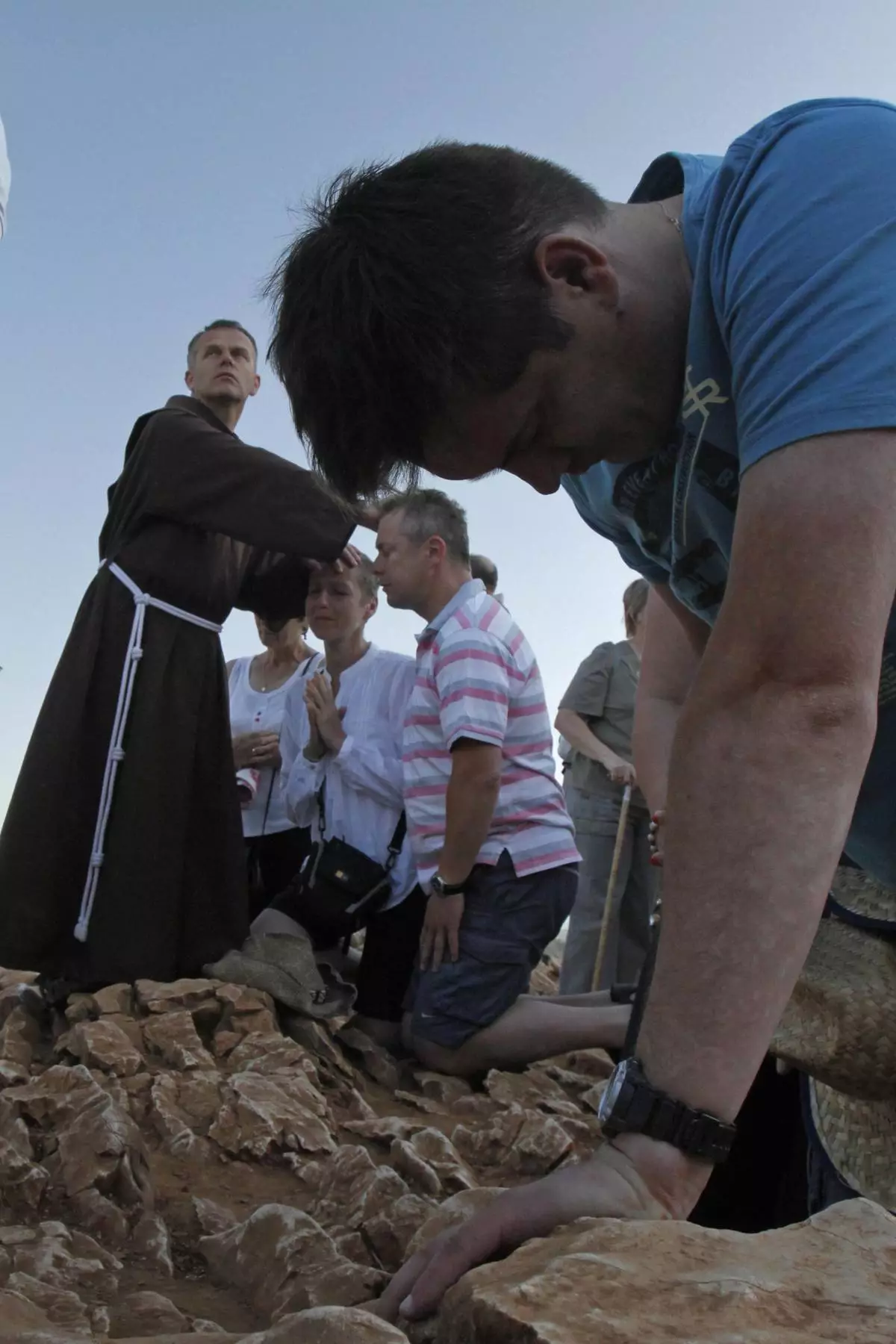
A Franciscan friar blesses pilgrims as they kneel in prayer around a statue of the Virgin Mary at the Hill Of Appearance in the southern Bosnian town of Medjugorje,160 kms south of Sarajevo, Saturday, June 25, 2011, where it is believed that the Virgin Mary showed herself and conveyed messages of peace to six children on June 25, 1981. On Friday, May 17, 2024, the Vatican will issue revised norms for discerning apparitions "and other supernatural phenomena," updating a set of guidelines first issued in 1978. (AP Photo/Amel Emric, File)
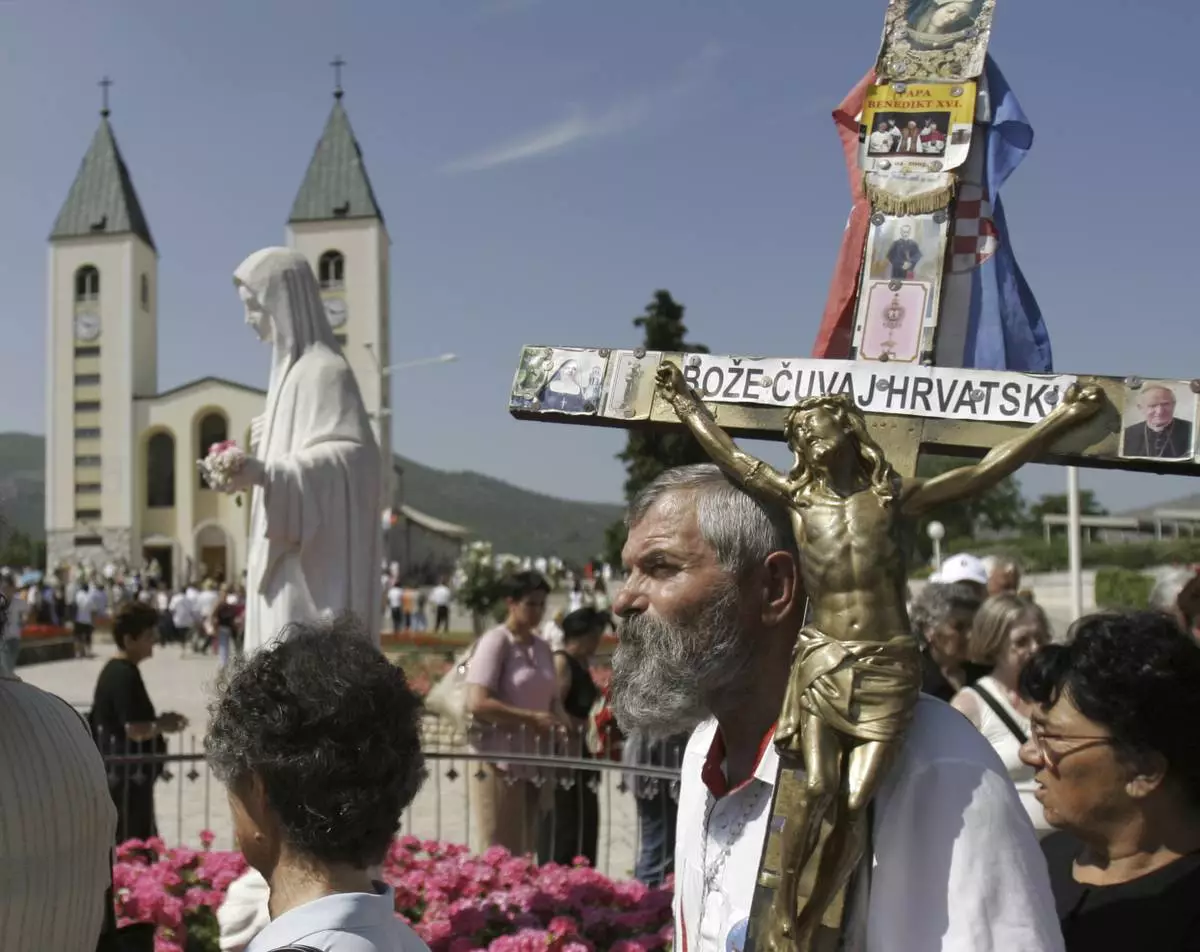
Pilgrims walk around a statue of the Blessed Virgin Mary near the church of St. James in Medjugorje, Bosnia and Herzegovina, some 120 kilometers (75 miles) south of the Bosnian capital of Sarajevo on Sunday, June 25, 2006. On Friday, May 17, 2024, the Vatican will issue revised norms for discerning apparitions "and other supernatural phenomena," updating a set of guidelines first issued in 1978. (AP Photo/Amel Emric, File)
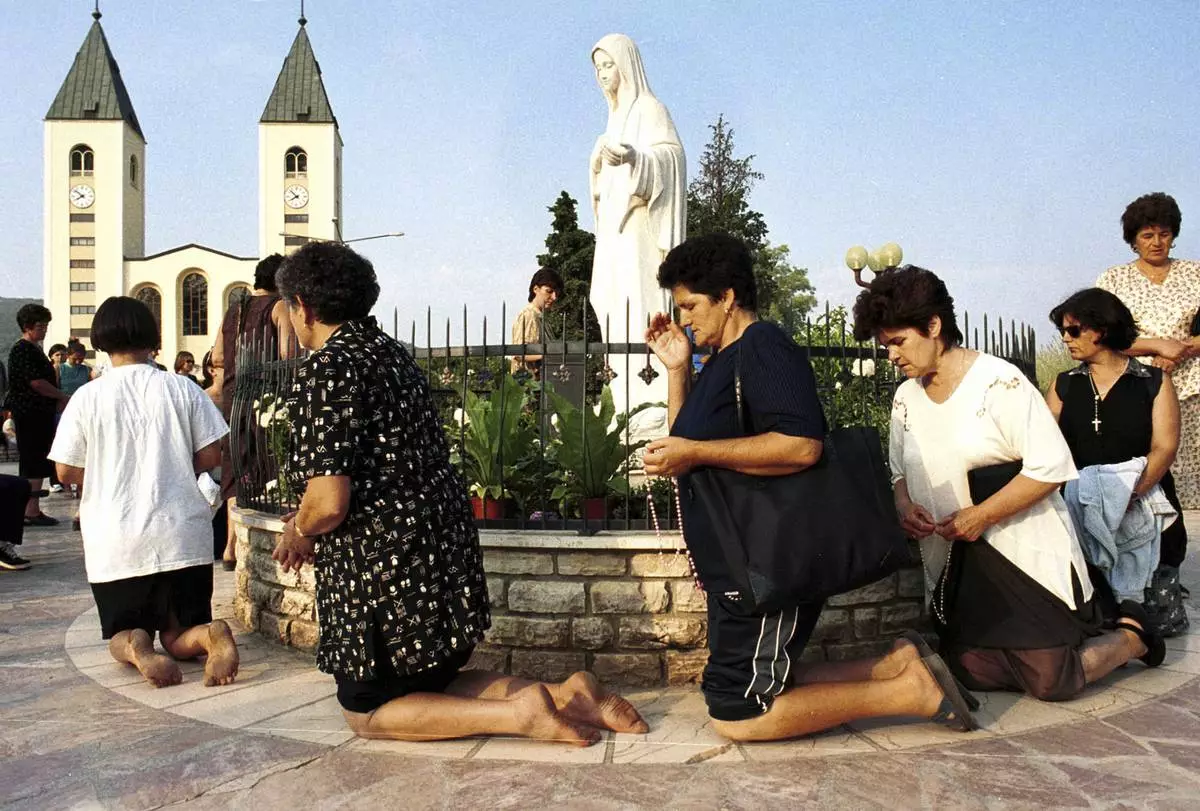
Bosnian Roman Catholic women pray on the occasion of the feast of the Assumption in Medjugorje, some 120 kilometers (75 miles) south of the Bosnian capital Sarajevo on Tuesday, August 15, 2000. Some 19 years ago six young people claimed Holy Mary appeared to them in the town of Medjugorje. On Friday, May 17, 2024, the Vatican will issue revised norms for discerning apparitions "and other supernatural phenomena," updating a set of guidelines first issued in 1978. (AP Photo/Hidajet Delic, File)



















